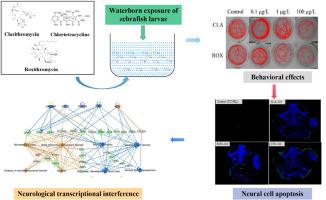The neurobehavioral impacts of typical antibiotics toward zebrafish larvae
Abstract
Due to the widely usage in livestock, aquaculture and clinics, antibiotic residues are existed in aqueous environments and their potential toxicity to aquatic organisms is concerning. Here, we used zebrafish as the model to investigate the neurotoxicity and involved mechanism of seven antibiotics that were frequently detected in surface waters. The results revealed that the short-term exposure to clarithromycin (CLA), chlortetracycline (CTC) and roxithromycin (ROX) induced behavioral effects, with effective concentration of 1 μg/L (CTC and ROX) and 100 μg/L (CLA, CTC and ROX) respectively. A significant decrease in the travel distance and velocity as well as an increase in turn angle was measured. TUNEL assay identified increased cell apoptosis in brain sections of larvae exposed to three neurotoxic antibiotics, which raised the possibility that the behavioral symptoms were associated with neural damage. Transcriptome sequencing showed that the three antibiotics could affect the nervous system of zebrafish including the alteration of synaptogenesis and neurotransmission. Additionally, ROX and CTC affected pathways involved in mitochondrial stress response and endocrine system in zebrafish larvae. Besides, BDNF, ASCL1, and CREBBP are potential upstream regulatory factors that mediated these impacts. These findings indicated that exposure of CTC, ROX and CLA may cause abnormal behavior toward zebrafish larvae under environmental relevant concentration and revealed the potential role of neural cell apoptosis and synaptogenesis signaling in mediating this effect.


 求助内容:
求助内容: 应助结果提醒方式:
应助结果提醒方式:


